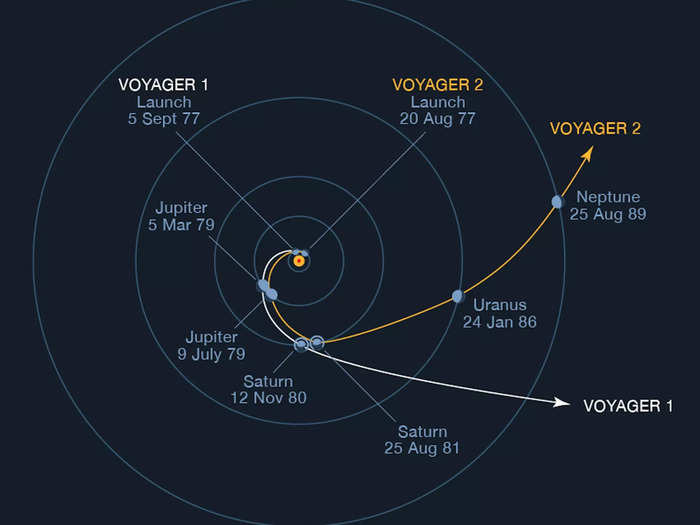
This montage shows examples of striking images of the solar system taken by Voyager 1 and 2 on their missions.NASA/JPL/Insider
The Voyager probes are pioneers of science, making it further into space than any other object made by humans.
Originally sent on a four-year mission to Jupiter and Saturn in 1977, the twin probes exceeded all expectations, and are still going 45 years later.
Among their achievements are the amazing photos of the solar they beamed back before the cameras were shut down.
But now, they face a terminal problem: their power is running out, and NASA scientists are starting to shut down even more instruments on board to conserve energy.
As they near the end of their mission, here are 18 images from Voyager that changed science:

The Voyager mission was made up of two probes, Voyager 1 and 2, which were launched in 1977 within a few months of each other.
The launches capitalized on a rare alignment of planets that allowed them to turbocharge their journeys into space.
They originally were built to last five years, but have exceeded that lifespan many times.

Voyager 1 and 2 reached Jupiter in 1979. They took about 50,000 pictures of the planet altogether, which greatly exceeded the quality of the pictures taken from Earth, according to NASA.
The pictures taught scientists important facts about the planet's atmosphere, magnetic forces, and geology that would have been difficult to decipher otherwise.


The probe captured this picture as it was looking back at the planet backlit by the Sun.


In 1980 and 1981, the probes reached Saturn. The flyby gave unprecedented insight into the planet's ring structure, atmosphere, and moons.




Voyager 1 continued straight on and would not come across another planet on its journey out of the solar system.
But Voyager 2 kept on its exploration of our nearest planets, passing within 50,600 miles of Uranus in January 1986.
It discovered an extra two rings around Uranus, revealing the planet had at least 11, not 9.

Here is a picture of a Miranda, Uranus's sixth-biggest moon.

In 1989, 12 years after its launch, Voyager 2 passed within 3,000 miles of Neptune.


It captured Triton, Neptune's moon in unprecedented detail.



Voyager 2 would never take pictures again. Since it wouldn't come across another planet on its ongoing journey, NASA switched off its cameras after its flyby of Neptune to conserve energy for other instruments.

As its last photographic hurrah, Voyager 1 took 60 images of the solar system from 4 billion miles away in 1990.

This is likely to remain the longest-ranging selfie in the history of humankind for some time, a portrait of the Earth from 4 billion miles away.
After this picture, Voyager 1's cameras were also switched off to save energy. It is possible for the probes' cameras to be switched back on, but it is not a priority for the mission.

Though the probes are no longer sending pictures, they haven't stopped sending crucial information about space.
In 2012, Voyager 1 became the first human-made instrument to cross into interstellar space by passing the heliopause, the boundary between our solar system and the rest of the universe.
Voyager 2 was the second, crossing the boundary in 2018. It then revealed there was an extra boundary surrounding our solar bubble.
The probes keep sending back measurements from interstellar space, like weird hums likely coming from vibrations made by neighboring stars.

Now NASA is starting to switch off the probes' last instruments with the hope of extending their life to the 2030s.
But even after all instruments become quiet, the probes will still drift off carrying the golden record, which could provide crucial information about humanity should intelligent extraterrestrial life exist and should it come across the probes.
 Colon cancer rates are rising in young people. If you have two symptoms you should get a colonoscopy, a GI oncologist says.
Colon cancer rates are rising in young people. If you have two symptoms you should get a colonoscopy, a GI oncologist says. I spent $2,000 for 7 nights in a 179-square-foot room on one of the world's largest cruise ships. Take a look inside my cabin.
I spent $2,000 for 7 nights in a 179-square-foot room on one of the world's largest cruise ships. Take a look inside my cabin. An Ambani disruption in OTT: At just ₹1 per day, you can now enjoy ad-free content on JioCinema
An Ambani disruption in OTT: At just ₹1 per day, you can now enjoy ad-free content on JioCinema Vegetable prices to remain high until June due to above-normal temperature
Vegetable prices to remain high until June due to above-normal temperature
 RBI action on Kotak Mahindra Bank may restrain credit growth, profitability: S&P
RBI action on Kotak Mahindra Bank may restrain credit growth, profitability: S&P
 'Vote and have free butter dosa': Bengaluru eateries do their bit to increase voter turnout
'Vote and have free butter dosa': Bengaluru eateries do their bit to increase voter turnout

Copyright © 2024. Times Internet Limited. All rights reserved.For reprint rights. Times Syndication Service.